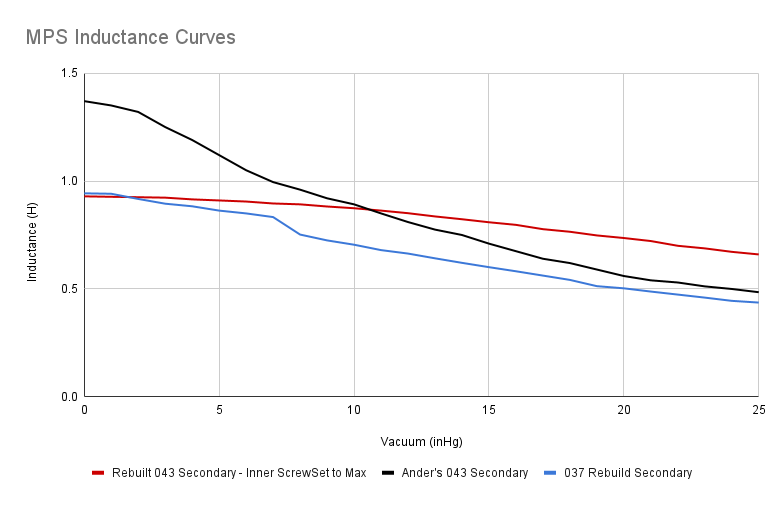After much investigation and many suggestions, I was able to isolate the issue to the MPS, a rebuilt 0280100043 unit, remanufactured by Fuel Injection Corp USA and sold by Rich Bontempi's High Performance House back in 2020. Last fall, I was able to get the car running, idling great and driving spottily by simply using the Tangerine Racing MPS tuning kit to adjust the inner idle screw richer, but was never able to achieve full throttle. I ended up cranking the inner screw up to max, and was able to get about 60% throttle before the engine would die. Although idle became excessively rich, this made the car driveable enough to get it hot. Especially since nearing the cut-out point, it seemed to get very lean.
With the warmer weather back, I've been working on trying to tune the car in better, but have been met without much success. But I've dialed in with growing specificity toward what seems to be an MPS transformer problem.
I started by doing a full intake system rebuild/re-seal, just to be certain I wasn't fighting a vacuum leak. Slowly and carefully cleaning and re-seating all mating surfaces and using gasket dressing on gaskets. (I also 3D scanned and modeled the intake system, but that's a topic for another thread.) I'm now up to 100% confident that the car has no vacuum leaks, up from maybe 85-90% before.
Then I set about adjusting the tuning. I got a proper vacuum pump that could pull up to 25+ inHg and bench tested my MPS. Like last time, the 8-10 coil (secondary) curve came in FAR lower than both the graph value and chart values given on Brad Ander's MPS page, at least on the high-power end of the scale, with the primary coil being around 1/2 the secondary. [Graphs and chart shown below.]
With the inner screw maxed out, the 25inHg primary inductance secondary 0.67H and the primary 0.32H. At 0inHg, the secondary approaches .93H and the primary, .49H.
Now, I had posted this very low inductance curve in my last thread, and the community consensus was that the shape of the curve was more important than the actual values, but I question this, and wanted to test where the cutout point on my engine's throttle response was, so I hooked a vacuum gauge up to a long hose, plugged it into the manifold port where the decel valve usually goes, and went for a drive.
After letting the engine get hot, I did a few pulls, where I gradually increased my throttle position and watched the vacuum.
Sure enough, the engine would cut out each time the manifold vacuum fell below about 7-8inHg on the gauge, which is just past the intercept point between my MPS's secondary curve, and the 043 curve Brad has posted on his site.
This aligned well enough with my suspicions that I was willing to spend the money to test out another unit. I went out looking, and settled on a 0280100037 unit from EBS Racing, since I couldn't find any verified '043s, and '037s are compatible with my car/ECU - considered to be an "upgrade" due to their higher stock mixture setting.
When this one arrived, I found it had also been remanufactured by Fuel Injection Corp. And upon testing its coils, while the curve's shape looked much healthier than my '043's, it was similarly very low. And sure enough, the car wouldn't start on it. What's more, I found that on this unit, the inner adjustment screw was nearly maxed out already, only about a quarter turn from its limit.
At this point, I'm scratching my head a bit. Could I really have gotten 2 bad rebuilds in a row? Does the inductance value really not matter, and there's something else wrong with my car? Why are my values both so different than the nominal ones Brad measured?
I checked that my LCR meter isn't bad with a 2.2H coil from DigiKey, and it read that more or less dead on. I also pulled the top off my '043 and checked to see that the transformer actuation is free and clear. Even with the core pulled to its limit, the secondary won't go much above 1.0H. The resistances in the coils are correct, so they're not shorted. All I can think is maybe the cores have been replaced with something non-suitable?
I know Jeff drove his car with my components last summer, which is further confusing, though I don't know if he tried full throttle or not, and I know my 2056 pulls a little less vacuum than an engine with a stock cam.

Values:
Brad Ander's 043 (based on 2 rebuilt and 1 NOS unit)
0 inHg = 1.39H
4 inHg = 1.18H
15 inHg = 0.71H
My Rebuilt 043
0 inHg = 0.929H
4 inHg = 0.915H
15 inHg = 0.809H
Brad Ander's 037 (based on 1 rebuilt unit)
0 inHg = 1.44H
4 inHg = 1.26H
15 inHg = 0.72H
My Rebuilt 043
0 inHg = 0.943H
4 inHg = 0.883H
15 inHg = 0.601H
So I guess, I'd like to ask the forum a favor. Anyone who has an LCR meter and a WORKING D-Jetronic car, if you're willing, do me a favor and check the inductance across your 8-10 coil with no vacuum, and post it here. If you feel like graphing your response curve, all the better!
